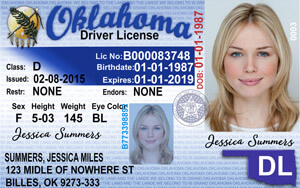- Updated for March 2025
- Based on official Oklahoma 2025 Driver's manual
Free Oklahoma SOK Motorcycle Permit Practice Test 2025
Did you know that Oklahoma is home to a portion of the historic Route 66? Driving on this road is a privilege that few get to experience. Some residents of the Sooner State prefer to explore this famous road on two wheels, especially during the summer months when the sun sets late in the evening. Oklahoma offers a diverse landscape suitable to motorcyclists of all skill levels. Riding a classic Harley-Davidson or an off-road KTM 390 Adventure through the state’s numerous parks is an experience like no other. But before you can turn this dream into reality, you must follow state law and obtain a motorcycle license.
We’ll help you pass the official motorcycle knowledge exam and shorten the time to go through the licensing process. However, you must be consistent in your studies and dedicate enough time and effort to your learning journey. Start by studying the official SOK motorcycle operator manual (Oklahoma Motorcycle Manual), which describes the various aspects of riding theory in detail.
Once ready, use our Oklahoma SOK motorcycle permit practice tests to evaluate your knowledge. This intuitive tool has been designed to help you become a safe and responsible rider, one who follows local laws and sets a good example for aspiring riders. Each practice test consists of 30 multiple-choice questions. Use the “Test settings” menu on the left side of the page to customize your experience and enhance your training sessions. Activate the answer popularity function to display the percentage of users who have chosen each answer. This feature helps you identify difficult questions where misconceptions are more common.
Our helpful automated assistant can boost your learning potential by providing real-life examples and personalized answers to your individual questions. Stuck on a difficult question? Request a hint that nudges you in the right direction without revealing the correct answer. Use our practice tests alongside the official motorcycle operator manual to study more efficiently and strengthen your understanding in a shorter time.
- Perfect for learner’s permit, driver’s license, and Senior Refresher Test
- Triple-checked for accuracy
What you need to know

What to expect on the actual OK SOK exam
questions
correct answers to pass
passing score
minimum age to apply
List of questions (classic view)
- When riding in a group, motorcyclists should usually ride
- When loading saddlebags, you should
- You can help other vehicle operators notice that you are slowing down by
- As you approach an obstacle that you will need to ride over, you should
- Each lane of traffic has ______ lane position(s) in which a motorcycle may travel.
- When you're starting your motorcycle, your right wrist should be positioned
- When you're riding at night, what is the best way to identify bumps in the road?
- How can you prevent fatigue while riding?
- If a dog starts to chase you while you're riding, you should
- When you're riding in a group, who sets the pace of the group?
- When approaching a blind intersection with a stop line, you should stop first
- Which of the following is a way to reduce your reaction time?
- When is it important to check your mirrors?
- Motorcyclists may find it challenging to maintain safe control on surfaces with poor traction, such as
- The center lane position is best for
- At an intersection controlled by signs or signals, how can you ensure that a car driver will notice you?
- When changing lanes on a multilane road, it is important to check the lane next to you and
- To ride safely on a slippery surface, you should
- When crossing an obstacle, you should cross it at an angle of at least _____ degrees.
- Which of the following does NOT affect your blood alcohol content?
- What can cause the engine to lock?
- ______________ helps you absorb shock when riding over obstacles.
- Distances are harder to judge at night. You should
- Tinted eye protection
- If you need to brake and swerve, you should
- What should you do on Step 3 of passing?
- When you are being passed from behind,
- Which portion of the lane should you be in before starting to pass?
- What should you do to avoid colliding with a vehicle cutting in?
- As you are riding, an object appears suddenly in your path. What should you do?
- Alabama: Test 1 / Test 2
- Alaska: Test 1 / Test 2
- Arizona: Test 1 / Test 2
- Arkansas: Test 1 / Test 2
- California: Test 1 / Test 2
- Colorado: Test 1 / Test 2
- Connecticut: Test 1 / Test 2
- Delaware: Test 1 / Test 2
- District of Columbia: Test 1 / Test 2
- Florida: Test 1 / Test 2
- Georgia: Test 1 / Test 2
- Hawaii: Test 1 / Test 2
- Idaho: Test 1 / Test 2
- Illinois: Test 1 / Test 2
- Indiana: Test 1 / Test 2
- Iowa: Test 1 / Test 2
- Kansas: Test 1 / Test 2
- Kentucky: Test 1 / Test 2
- Louisiana: Test 1 / Test 2
- Maine: Test 1 / Test 2
- Maryland: Test 1 / Test 2
- Massachusetts: Test 1 / Test 2
- Michigan: Test 1 / Test 2
- Minnesota: Test 1 / Test 2
- Mississippi: Test 1 / Test 2
- Missouri: Test 1 / Test 2
- Montana: Test 1 / Test 2
- Nebraska: Test 1 / Test 2
- Nevada: Test 1 / Test 2
- New Hampshire: Test 1 / Test 2
- New Jersey: Test 1 / Test 2
- New Mexico: Test 1 / Test 2
- New York: Test 1 / Test 2
- North Carolina: Test 1 / Test 2
- North Dakota: Test 1 / Test 2
- Ohio: Test 1 / Test 2
- Oklahoma: Test 1 / Test 2
- Oregon: Test 1 / Test 2
- Pennsylvania: Test 1 / Test 2
- Rhode Island: Test 1 / Test 2
- South Carolina: Test 1 / Test 2
- South Dakota: Test 1 / Test 2
- Tennessee: Test 1 / Test 2
- Texas: Test 1 / Test 2
- Utah: Test 1 / Test 2
- Vermont: Test 1 / Test 2
- Virginia: Test 1 / Test 2
- Washington: Test 1 / Test 2
- West Virginia: Test 1 / Test 2
- Wisconsin: Test 1 / Test 2
- Wyoming: Test 1 / Test 2
Your go-to, trusted source
Experience the Driving-Tests differenceOur commitment to accuracy and quality in our practice tests
Explore our rigorous, multi-tiered verification process that ensures each question mirrors the official manual for unparalleled accuracy.

At Driving-Tests.org, we understand the importance of reliable and accurate practice tests to help you prepare for your DMV exam. That's why we've developed a meticulous process to create and continually update our practice questions, ensuring they reflect the most current driving laws and regulations.
Here's an inside look at how we maintain the highest quality in our practice tests.
Content Creation and Verification Process
- Alignment with Official Manuals:
Every question we develop is based on the most recent version of each state's official driving manual. Our team regularly monitors each state DMV's website for the latest updates to ensure our practice tests are always aligned with the most current information. - Community Feedback Integration:
We leverage feedback from our vast community of users to understand which topics are most frequently tested. This helps us focus on the areas that are most relevant and beneficial for your preparation. - Expert Content Creation:
Our in-house editor, Steven, who has extensive experience in driver education, crafts each question with precision. He conducts a thorough review of each question against the official manuals to ensure accuracy. - Rigorous Review Process:
Once Steven has finalized a set of questions, our team conducts a joint review session. This second level of scrutiny involves content accuracy, proofreading, and fact-checking to eliminate any errors. - User Feedback Mechanism:
After a question goes live on our site, we keep the lines of communication open. Each question features a feedback button, inviting users to report any issues or errors. This continuous feedback loop allows us to address and rectify any concerns promptly. - Responsive Updates:
In line with our commitment to accuracy, we quickly update our practice questions to reflect any changes in the DMV manuals. Additionally, we update the free electronic copy of the state's driver's license manuals on our site, typically within a few days after the DMV publishes them.
Our thorough quality control process ensures that you have access to practice tests that are as accurate and up-to-date as possible. We believe in the power of well-prepared drivers and are dedicated to providing you with the best study tools to help you succeed on your DMV exam.
Pass the First Time. Guaranteed.
Be fully prepared in days, not weeks. Get full access to our entire program, starting at $49.
950 Exam-Like Questions
Unlock state-specific questions vetted by DMVs and seen on the official exam.
Industry-Leading 97% Success Rate
Compare with the average US passing rate of 49%.
Trusted by over 1.15 Million customers
The only program recommended by DMVs.

